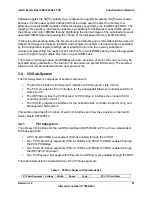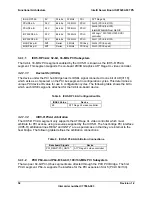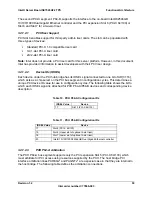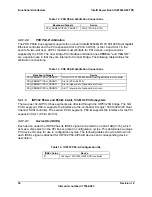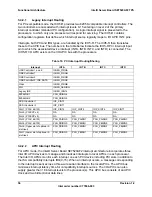
Functional Architecture
Intel® Server Board SE7520AF2 TPS
60
Revision
1.2
Intel order number C77866-003
3.4.3 SCSI
Support
The SCSI sub-system on the Intel® Server Board SE7520AF2 is enabled via the LSI Logic*
53C1030 Dual Channel Ultra 320 SCSI controller, two internal 80-pin connector (SCSI Channel
A and Channel B), and on-board termination for both SCSI channels.
3.4.3.1
LSI Logic* 53C1030 Dual Channel Ultra 320 SCSI Controller
The LSI Logic* 53C1030 is a PCI-X to Dual Channel Ultra320 SCSI Multifunction controller that
supports the
PCI Local Bus Specification, Revision 2.2
, and the
PCI-X Addendum to the PCI
Local Bus Specification, Revision 1.0a.1
.
The LSI Logic* 53C1030 supports up to a 64-bit, 133 MHz PCI-X bus. The Ultra320 SCSI
features for the LSI Logic* 53C1030 include: double transition (DT) clocking, packetized
protocol, paced transfers, quick arbitrate and select (QAS), skew compensation, inter-symbol
interference (ISI) compensation, cyclic redundancy check (CRC), and domain validation
technology. These features comply with the American National Standard Institute (ANSI) T10
SCSI Parallel Interface-4 (SPI-4) draft specification.
DT clocking enables the LSI Logic* 53C1030 to achieve data transfer rates of up to 320
megabytes per second (MB/s) on each SCSI channel, for a total bandwidth of 640 MB/s on both
SCSI channels. Domain Validation detects the SCSI bus configuration and adjusts the SCSI
transfer rate to optimize bus interoperability and SCSI data transfer rates. Domain Validation
provides three levels of domain validation, assuring robust system operation.
The LSI Logic* 53C1030 integrates two high-performance SCSI Ultra320 cores and a 64-bit,
133 MHz PCI-X bus master DMA core. The LSI Logic* 53C1030 employs three ARM966E-S
processors to meet the data transfer flexibility requirements of the Ultra320 SCSI, PCI, and PCI-
X specifications. Separate ARM* processors support each SCSI channel and the PCI/PCI-X
interface. These processors implement the LSI Logic* Fusion-MPT* architecture, a
multithreaded I/O algorithm that supports data transfers between the host system and SCSI
devices with minimal host processor intervention. Fusion-MPT technology provides an efficient
architecture that solves the protocol overhead problems of previous intelligent and non-
intelligent adapter designs.
3.4.3.1.1
LSI Logic* 53C1030 Integrated Mirroring and Integrated Striping
The LSI Logic* 53C1030 supports the LSI Logic* Integrated Mirroring Enhanced (IME) and
Integrated Striping (IS) technology, which provides physical mirroring or striping of the boot
volume through LSI Logic* 53C1030 firmware. These features provide extra reliability and
performance for the system’s boot volume without burdening the host CPU.
The use of a second disk as a mirror requires the LSI Logic* Fusion-MPT* firmware, which
performs writes to both the boot drive and the mirrored drive. Runtime mirroring or striping of the
boot drive is transparent to the BIOS, drivers, and operating system.
The IME and IS firmware requires a configuration mechanism, which enables configuration of
the mirroring or striping attributes during initial setup or reconfiguration after hardware failures or
changes in the system environment. To configure the IME or IS attributes the LSI Logic* BIOS
Configuration Utility should be used; this can be accessed by pressing
<CTRL+C>
during
POST. Using the LSI Logic* BIOS and drivers adds support of physical device recognition for






